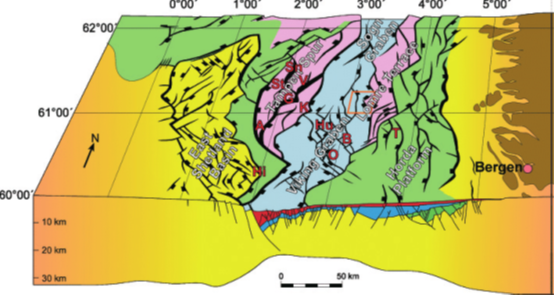By 2025 a quiet revolution has been taking place in the laboratories and computer rooms of our research group. Over three short years, bachelor’s and master’s students have followed the same question down very different paths: how do we keep the lights on while cutting the carbon?
Blog post
The blogpost is written by
Text produced using ChatGPT5.0.
A Sea of Carbon – And Possibilities
To many people the North Sea is still shorthand for oil, but the students who came through our department between 2023 and 2025 looked at its sandstones, salt layers and ancient rift basins and saw something else: a giant natural laboratory for storing the very carbon that fuels climate change.
Some modelled injected CO₂ in detail. Arziye Pekdemir used Halliburton’s Permedia software to watch a digital plume of carbon snake its way through the Luna licence, discovering that natural dips in the rocks would push it toward neighbouring fields, a geological nudge that makes cooperation between operators essential. In parallel, Martine Aarstad and Marie Aske worked further south, scanning 3D seismic cubes of the Atlas and Havstjerne licenses to estimate how many millions of tonnes of CO₂ the reservoirs could lock away. Their numbers, 7 Mt and 24 Mt, respectively, are the kind of figures that turn an abstract climate target into something you can actually store underground.
Safety matters as much as capacity. Magnus Nyheim examined mineral reactions in existing Norwegian storage sites and found that the rocks themselves help trap carbon by turning it into solid carbonate minerals. Simon Østreng Veland looked above ground, analysing the economics and policies behind the Northern Lights CO₂ network and showing how shared pipelines and storage sites can give heavy industry a fighting chance of meeting the Paris Agreement.
Farther afield, Olarewaju Balogun and Aikaterini Kourtoglou explored mature oilfields such as Brage and Ula, revealing that yesterday’s petroleum reservoirs can become tomorrow’s carbon vaults—together offering storage potential measured in hundreds of millions of tonnes.
And at the northern edge of the Barents Sea, Faiz Hirzi Ridhadin blended high-resolution seismic interpretation with fluid-flow modelling to follow natural gas migration through the Snøhvit Field. His work shows how faults and gas “chimneys” evolve over time, knowledge that is critical not only for hydrocarbon exploration but also for ensuring the long-term safety of CO₂ storage sites.
Carbon as a Tool, Not Just a Problem
Several students went one step further: why merely store CO₂ when you can use it to squeeze out the last drops of oil while it settles safely underground?
Experiments by Simon Groven Iversen, Alfred Obo and Gustav Kvitvær tested carbonated water flooding in sandstones and chalk. They discovered that bubbling CO₂ through the injection water can both enhance oil recovery and lock carbon away, even at low temperatures.
Adding another layer to this story, Akwasi Ibrahim Agyei tested smart-water blends enriched with a surface-active ionic liquid. In chalk and limestone cores heated to 90°C, he found that ionic liquid concentrations above the “critical micelle” threshold produced significantly more oil than smart water alone, evidence that carefully tailored chemical cocktails can boost production and store CO₂ at the same time. Thashila Wickrama Arachchilage spiced the idea with chemistry, blending surfactants into “smart water” and finding a sweet spot where oil recovery jumped while micelles danced in the brine.
These techniques, known collectively as CCUS, for Carbon Capture, Utilisation and Storage, turn what was once a waste product into a working fluid of the energy transition.
Powering the Transition
Not every thesis lived underground. Emilie Mathiesen used Norway’s national energy-system model to test how offshore wind farms and power-from-shore could decarbonise oil and gas production. Her answer: a hybrid approach linking offshore turbines with cables from land delivers the biggest cut in emissions at the lowest cost.
And while some students worked on how we generate electricity, Muhammad Imran Haider Abid focused on how to use it wisely. He trained a machine-learning algorithm to decide when a commercial battery should charge or discharge. By predicting solar output and electric-vehicle demand, his model cut operating costs and proved that artificial intelligence can wring more value from every kilowatt.
Omid Sultani brought a life-cycle perspective, comparing traditional gas-turbine power on the Gullfaks and Snorre platforms with electricity from the Hywind Tampen floating wind farm. His analysis shows that offshore wind, especially when coupled with existing oil and gas infrastructure, can slash greenhouse-gas emissions and meet net-zero goals without compromising energy security.
Innovating the Subsurface
Beneath these applied projects runs a current of pure geology. Håvard Skipevåg mapped the Fenja area’s Jurassic rift basins, showing how ancient faults guided sand into submarine fans and shoreface deposits—knowledge that underpins both oil exploration and CO₂ storage. Deniz Seyfeli looked to the salt-rich Zechstein Group and found that the same formations that can be used to store hydrogen, could also hold compressed air for large-scale energy storage. Konstantinos Amvrosiatos examined diatomite outcrops whose sponge-like pores may serve equally well for hydrocarbon recovery or underground carbon storage.

Data science is now part of that geological toolkit. John Emeka Udegbunam and Reynel Isaac Villabona Gonzalez designed a federated workflow to analyse enormous digital palynological slides from the Norwegian Petroleum Directorate. Their privacy-preserving, containerised system lets algorithms travel to the data, rather than the other way around, opening the door to large-scale, AI-driven fossil analysis without the bottleneck of moving terabytes across networks.
And in the lab, Nicolas Mauricio Galindo Lopez explored how a nanoclay–polymer gel known as “ECO-clay” can block fractures in chalk reservoirs, cutting water permeability almost twenty-fold. The approach promises cleaner oil production by reducing unwanted water handling and the emissions that come with it.
A Joined-Up Future
Taken together, these projects sketch a North Sea future that is far more complex—and hopeful—than the region’s oil-rich past.
Carbon is no longer just the villain of the climate story: it is a working fluid, a resource to be steered and stored. Old oilfields are reborn as carbon vaults; chalk and sandstone reservoirs become both laboratory and battery; and the winds that whip across the North Sea feed power systems smart enough to know exactly when to store or spend every electron.
The students of 2023-2025 have not merely written theses; they have written the opening chapters of a low-carbon era—one where geology, engineering and data science combine to keep energy flowing while the planet cools. Their work shows that the path to net-zero is not a single technology or a single discipline, but a mosaic of ideas stitched together beneath and above the waves.
Referenced theses:
Arziye Pekdemir. 2025. Dynamic Simulation of CO₂ Migration Using Permedia Tool. Master’s thesis, University of Stavanger.
Martine Aarstad. 2025. Seismic Interpretation of the Northwestern Part of the Atlas CO₂ License and Preliminary Storage Capacity. Bachelor’s thesis, University of Stavanger.
Marie Aske. 2025. A Geological Evaluation of CCS License Havstjerne (EXL006), North Sea. Bachelor’s thesis, University of Stavanger.
Magnus Nyheim. 2025. Examining the Long-Term Safety of Underground CO₂ Storage. Bachelor’s thesis, University of Stavanger.
Simon Østreng Veland. 2025. Carbon Capture and Storage as a Climate Solution: A Case Study of the Northern Lights Project. Bachelor’s thesis, University of Stavanger.
Olarewaju Samuel Balogun. 2024. Geological Evaluation of CO₂ Storage Potential in the Northern North Sea: A Case Study from the Brage Field. Master’s thesis, University of Stavanger.
Aikaterini Kourtoglou. 2024. Geological Evaluation of CO₂ Storage in Depleted Oilfields: A Case Study in the Ula Field. Master’s thesis, University of Stavanger.
Simon Groven Iversen. 2025. Assessing the Effect of Carbonated Water on Enhanced Oil Recovery in Sandstones: A CCUS Study. Master’s thesis, University of Stavanger.
Thashila N. Wickrama Arachchilage. 2023. Surfactant-based Smart Water Enhanced Oil Recovery in Carbonate Rocks. Master’s thesis, University of Stavanger.
Alfred Obo. 2023. Enhanced Oil Recovery Potential by Carbonated Water Injection in Bentheimer Sandstones. Master’s thesis, University of Stavanger.
Gustav Kvitvær. 2023. Low-Temperature Carbonated Water Injection for Enhanced Oil Recovery in Chalk. Master’s thesis, University of Stavanger.
Emilie Alsaker Mathiesen. 2023. Energy System Modeling for the Integration of Offshore Wind and Onshore Power in Decarbonizing the Oil and Gas Industry. Master’s thesis, University of Stavanger.
Muhammad Imran Haider Abid. 2024. Optimizing Energy Storage System (ESS) for Charging and Discharging Operations via Machine Learning. Master’s thesis, University of Stavanger.
Håvard Skipevåg. 2024. Tectono-sedimentary Characteristics of Upper Jurassic Sedimentary Rocks in the Fenja Area, Norwegian Sea. Bachelor’s thesis, University of Stavanger.
Deniz Firat Seyfeli. 2023. Lithological Heterogeneities in the Zechstein Group: Compressed Air Energy Storage Opportunities in Salt Caverns. Master’s thesis, University of Stavanger.
Konstantinos Amvrosiatos. 2025. Laboratory Investigation of Geological Formations in the Field of Hydrocarbon Recovery and Underground Gas Storage Potential. Diploma thesis, Technical University of Crete.
Faiz Hirzi Ridhadin. 2024. Integrating Seismic Analysis and Subsurface Fluid Flow Modelling in Snøhvit Field, Barents Sea. Master’s thesis, University of Stavanger.
Omid Sultani. 2023. LCA Analysis for Sustainable Offshore Oil and Gas Production toward Net-Zero Emission: Gullfaks & Snorre Fields and Hywind Tampen Floating Wind Farm. Master’s thesis, University of Stavanger.
Nicolas Mauricio Galindo Lopez. 2023. Improvement of Volumetric Sweep Efficiency during Oil Production using ECO-clay. Master’s thesis, University of Stavanger.
John Emeka Udegbunam & Reynel Isaac Villabona Gonzalez. 2023. A Federated Computational Workflow for Analysis of DISKOS Digital Palynological Slides. Master’s thesis, University of Stavanger.
